Gone Truckin' Nuts — TTAC Compares Midsize Trucks
The midsize pickup truck market was once thought dead, particularly in the wake of seemingly unstoppable sales in the full-size class. But after General Motors brought forth updated generations of the Chevrolet Colorado and the GMC Canyon a few years ago, Ford brought the Ranger back to North American shores, realizing that it couldn’t sit on the sidelines, joining the Japanese stalwarts – the Toyota Tacoma and Nissan Frontier. Now midsize pickup market isn’t just heating up, it’s starting to catch fire.
To see if they’re up to the task of some good ‘ole classic four-wheelin’, I took part in an event that rounded them all up — well, nearly all of them — at the Anthracite Outdoor Adventure Area in Eastern Pennsylvania for a day to test their off-road chops.
Although they may not seem quite as imposing as the larger full-size pickups, these midsize brutes offer plenty of capability. Their smaller footprint also allows for easier maneuverability around tight trails. So a bunch of us auto journalists gathered up all the contenders in the most off-road-biased specification to duke it out for off-roading superiority: The Chevrolet Colorado ZR2 Bison, Ford Ranger FX4, Jeep Gladiator Rubicon, and Toyota Tacoma TRD Pro.
Nissan’s Frontier sat this one out because it’s seemingly older than planet Earth itself and a completely new model is supposedly on the way. Also sitting out was the GMC Canyon, which is available with optional soft-roader All Terrain X trim. That trim is still just essentially a nicer Colorado and the Canyon “ATX” still doesn’t come as decked-out and trail-ready as the AEV-approved Colorado ZR2 Bison.
The Anthracite Outdoor Adventure Area resides in the heart of Coal Township, Pennsylvania. Built upon 6,500 acres formerly dedicated to coal mines, the AOAA area consists of hundreds of miles of off-road trails for nearly all types of vehicles — a perfect testing ground for our four candidates.
In the four-wheeling world, a general scale between zero to five helps to classify the difficulty of trails based on vehicle capability: Zero is the easiest of trails, which any passenger vehicle could traverse largely without issue. Think basically a simple dirt or gravel road. On the opposite end of the spectrum is a five-rated trail, which even most purpose-built and road-legal four-by-fours can’t cross without extensive modification.
The trails we tackled brushed up upon a level-four trail, which typically necessitates the use of low-range, locking differentials, off-road tires, and high ground clearance.
(Ed. note: The bolded “what we liked” sections are unique to this comparo, and don’t signify a change to our review format. Unless, of course, you like them.)
So, which did it best?
- 2020 Jeep Gladiator
- What we liked: Every tool you’ll ever need to make off-roading an effortless experience; bad-ass long-bed Wrangler looks; an interior that always feels like an occasion
- What we didn’t like: Its length can make maneuvering tight spaces and sharp breakovers worrisome
- Verdict: The ultimate all-around overland and off-road midsize pickup
If there’s one thing to be said about the Gladiator, it’s that it lives up to its namesake in spades while answering the calls of pickup lovers and Wrangler lovers alike. Around AOAA, it was hard to find another contender that did everything so well, all around. Aside from being the perfect tool for the job on paper — four-wheel-drive with low-range and multiple locking differentials, electronically detachable sway bars, and nearly unbeatable approach and departure angles — the Gladiator is clearly built for the job.
When traversing over some of the rockiest bits and the toughest terrain we could find at AOAA, short of dirt bike trails, the Gladiator simply shrugged it all off as if it were a walk in the park. The suspension is clearly purpose-built and while all the other trucks seemed outrageously stiff and bouncy, the Gladiator ironed out all but the largest of rocks, making it the smoothest and most effortless truck to drive over the trails. The Jeep’s 3.6-liter V6 and eight-speed automatic is a pairing made in heaven.
- 2019 Chevrolet Colorado ZR2 Bison AEV
- What we liked: Bad-ass rugged looks, as tough as it appears, felt like it was the most capable of the bunch
- What we didn’t like: Bouncy ride and body motions when rock crawling, V6 needs a good revving to get into the powerband, confusing electronic four-wheel controls
- Verdict: If off-roading is the priority, the Colorado ZR2 Bison AEV is the sharpest tool of the bunch
The Colorado ZR2 Bison is the most rugged of the bunch with a seal of approval from one of the biggest names in aftermarket off-road equipment, American Expedition Vehicles. It clearly showed while exploring AOAA. With specially designed DSSV shock absorbers, 32–inch Goodyear Duratrac all-terrain tires, and AEV boron steel skid plates; We felt like we were just grazing the surface of the Colorado’s potential. With those grippy off-road tires and toughened undersides, any thought about getting stuck or damaging the undercarriage simply never crossed our minds.
There were a few compromises, however. While the Colorado excelled at its off-road capability and prowess, it did so at the expense of comfort, similarly to how a track-biased sports car isn’t the best daily driver. While seemingly the most capable, it also felt a bit taxing during the whole experience. While the Gladiator smoothly coasted over its obstacles, the Colorado bounced around and jostled its occupants as if we were actually trying to ride on the back of a wild bison.
- 2019 Ford Ranger FX4
- What we liked: Just as smooth over the trails as the Jeep, beefy turbo-four, easy maneuverability
- What we didn’t like: Least amount of ground clearance meant a lot of underbody bumping and scraping
- Verdict: Nearly as refined as the Gladiator, but with a much more tolerable length.
The Ford Ranger’s third-place rank in this comparison isn’t meant to disparage its off-road capability; as it handled everything we could throw at it just as well as all the other contenders. It’s certainly equipped for the job with its optional FX4 Off-Road Package, which features off-road-tuned shocks, Dana AdvanTEK independent axles, underbody steel skid plates, an electronic-locking diff, and controllable transfer case, and Ford’s latest Terrain Management System.
But the Ranger felt the most challenged by the terrain. It matches the Chevy for the least amount of ground clearance at 8.9 inches and thus, we found that it bumped and scraped over the rockier and rougher bits of AOAA, while all the others treaded over obstacles without needing extra care.
Otherwise, it was quite easy to drive the Ranger throughout the park, as long as the surface didn’t include large, pointy rocks. Similarly to the Gladiator, the Ranger just seemed to cruise smoothly over some of the rougher trails. Its 270-horsepower, 2.3-liter EcoBoost turbocharged four-cylinder convinced all of us that it felt like there was a greater cylinder count under the hood.
- 2019 Toyota Tacoma TRD Pro
- What we liked: One of the few in its class with a manual, a powerhouse of a motor, as rugged feeling as it looks
- What we didn’t like: The side rails with step extensions hindered ground clearance (so much that we accidentally broke one-off), poor outward visibility, cramped feeling interior
- Verdict: The oldest truck of the bunch, but the most honest-feeling workhorse, if that’s what you’re after
The Tacoma TRD Pro is probably the most seasoned truck here, having been around in its current guise since 2016. As a result, the Tacoma TRD Pro definitely feels like the truck most in need of an update, being almost void of any of the gadgets found in any of the other contenders. For example, it didn’t have hill-descent control, a result of having a manual transmission. The upside to the minimalistic package is that the Tacoma probably felt like the purist truck of the bunch, if not a bit old-school.
Its 3.5-liter naturally-aspirated V6 is an absolute powerhouse and probably the most-desired engine of the bunch. With plenty of low-end grunt, it made rock crawling and water fording seem effortless. With low-range engaged, the Tacoma confidently climbed over the rocky bits while sitting at idle in first gear, proving that it’s clearly up to the task.
If you’re looking for the most honest and fluff-free trucks of them all, then the Tacoma TRD Pro is the truck to get, despite its dated feeling.
No matter the terrain: Whether it be dirt, rocky trails, muddy water pits, or steep inclines that left nothing but the sky as the view forward, all of these trucks are clearly built for places like AOAA. What it all comes down to really is a matter of splitting hairs. All of our contenders are purpose-built machines with more than enough grunt and capability to tackle some of nature’s most difficult surfaces. It comes down to which machine suits your needs and purposes and where your taste lies. But one thing’s for sure, all these trucks are certainly up to the task.
That said, we rated the Gladiator as the best overall of the bunch. Chalk another one up for the Jeep.
[Images © 2019 Chris Chin/TTAC]
More by Chris Chin
Latest Car Reviews
Read moreLatest Product Reviews
Read moreRecent Comments
- Lou_BC Well, I'd be impressed if this was in a ZR2. LOL
- Lou_BC This is my shocked face 😲 Hope formatting doesn't fook this up LOL
- Lou_BC Junior? Would that be a Beta Romeo?
- Lou_BC Gotta fix that formatting problem. What a pile of bullsh!t. Are longer posts costing TTAC money? FOOK
- Lou_BC 1.Honda: 6,334,825 vehicles potentially affected2.Ford: 6,152,6143.Kia America: 3,110,4474.Chrysler: 2,732,3985.General Motors: 2,021,0336.Nissan North America: 1,804,4437.Mercedes-Benz USA: 478,1738.Volkswagen Group of America: 453,7639.BMW of North America: 340,24910.Daimler Trucks North America: 261,959



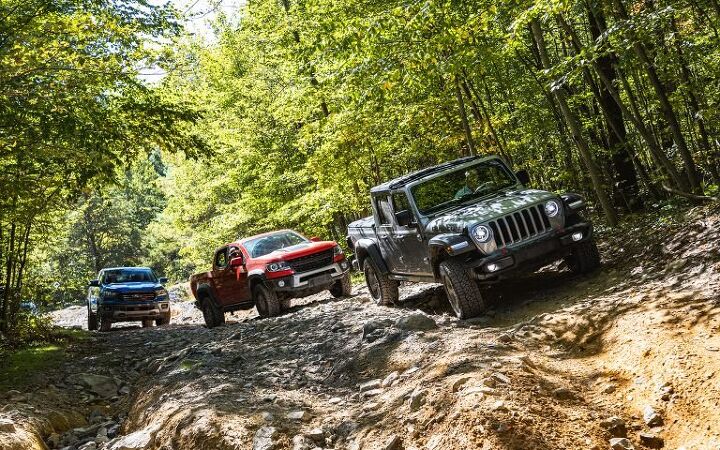























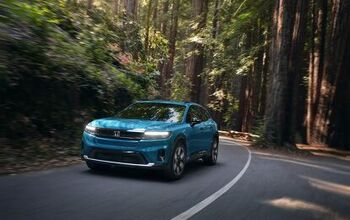
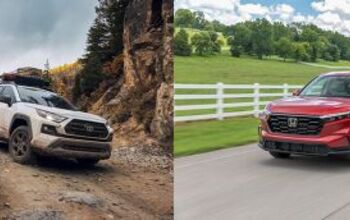

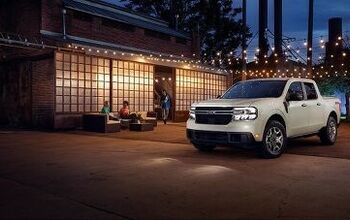
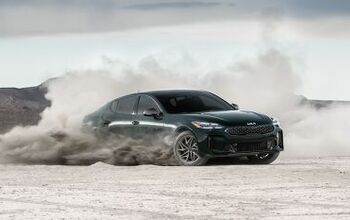






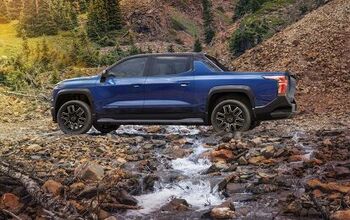

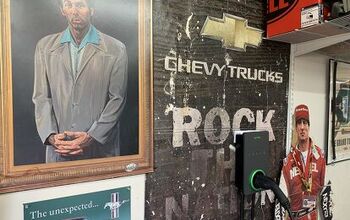

Comments
Join the conversation
What about the Chevrolet's rubbish interior. It is a GM vehicle after all.
"Anthracite Outdoor Adventure Area in Eastern Pennsylvania" Northumberland County. My 4th grade teacher lived in Frackville and commuted everyday 60+ miles to Northampton County in a.....Ford Festiva.... He was a former college basketball player, so I'm not sure if he was just thrifty or thought a 6'6" man in a Festiva was hilarious. Never missed a day because of weather though. And he lived where it was MUCH snowier than where I lived. Anyway, AOAA is cool. Rode along with a friend once, an easy drive down I-81 from were I went to college. My only experience off-roading in a truck. It was fun, but I've never been able to justify owning a vehicle to do that since my everyday needs as an adult are so different.